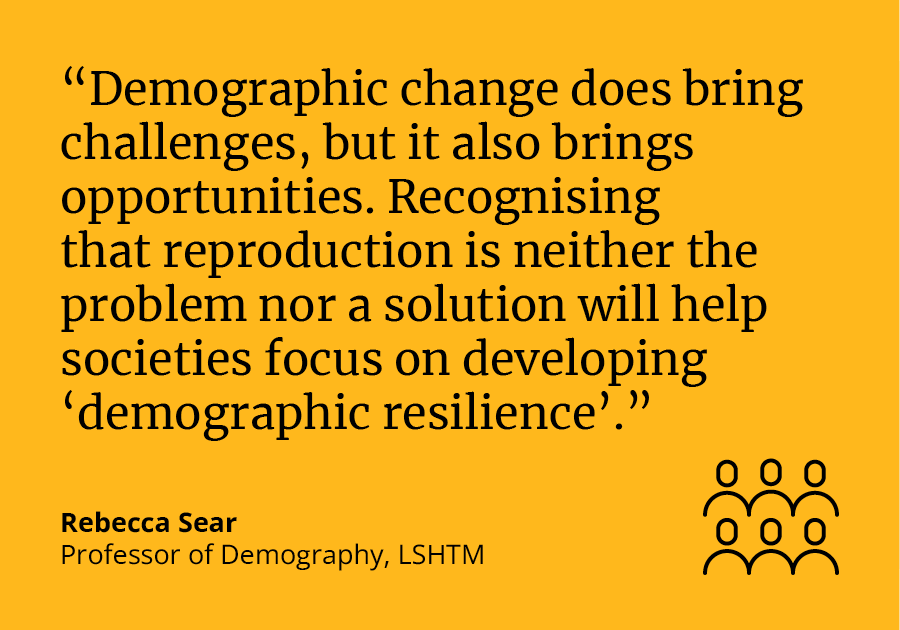Why we must focus on human rights, not population targets
London School of Hygiene & Tropical Medicine https://lshtm.ac.uk/themes/custom/lshtm/images/lshtm-logo-black.png Wednesday 19 April 2023
In 2022, global population reached eight billion people. This milestone represents a hugely positive story of human achievement in reducing mortality rates worldwide. A couple of centuries ago, life expectancy at birth for the average global citizen would have been in the 30s or below; so low because high proportions of children died in their first few years of life. Child mortality has since plummeted, meaning far fewer families have to grieve children lost in childhood, and far more children grow up to achieve their full adult potential. The health of older people is also steadily improving, increasing life expectancies and population growth.
Yet demographic change is not always presented in a positive light. Fears of ‘overpopulation’ have circulated in Western media for decades, as plummeting mortality rates resulted in rapid population growth during the 20th century. In recent years, alarmism over ‘too many’ people in the world has received a boost because of increasing concern about human activity causing climate heating. But climate change is not just affected by the number of people on the planet, but by what those people are doing, and population growth is fastest in those parts of the world which have the lowest environmental footprint. Focusing on population growth as a cause of climate change is a distraction. Instead, we should be focusing on reining in those activities which are having the most damaging impact on the planet, and on mitigating the consequences of climate change where they are being felt most severely, typically also in those populations which have done least to cause climate change.
Surprisingly, more and more headlines now shout about ‘demographic collapse’, rather than ‘overpopulation’. A new narrative is rapidly emerging that the greatest threat to humanity is not too many people but too few. These concerns arise from observations of low and declining fertility rates. Low fertility (sometimes in combination with high emigration) has led to declines in the populations of a few higher income countries, and is projected to lead to population declines in more countries in future. Nevertheless, global population is still growing, and the planet is not in any danger of running out of people soon. Alarmism about ‘demographic collapse’ stems from concern about whose birthrates are declining. Fertility rates are low in particular sub-populations, and these low fertility rates have been used to fuel fears about the potential ‘replacement’ of these sub-populations by other groups. In the most extreme form of these ideas, ‘great replacement’ ideology claims the White race is in danger of being replaced by other races (an impossibility, given the consensus among geneticists and anthropologists that race has no biological meaning). This ideology has led to fatal terrorist attacks.
Whether these demographic doom narratives focus on ‘over-‘ or ‘under-population’, stoking fears about population change is highly problematic. One consequence may be the assumption that population policies must be focused on population change as the solution. Policies which are targeted explicitly at increasing or decreasing fertility rates inevitably risk undermining human rights. Fears of ‘overpopulation’ led to serious human rights abuses, including forced sterilizations and unethical use of inadequately-tested contraceptives. Fears of ‘underpopulation’ may lead to restrictions on reproductive healthcare and other policies which unhelpfully target fertility itself instead of considering the structural issues which result in low fertility. Many women in low fertility societies state desires for more children than they end up having. Why so many women are falling short of the family sizes they prefer should be a cause for concern, but providing ‘baby bonuses’ to women who have children may do little to tackle the underlying problems of family-unfriendly workplaces, and economic precarity which lead women to downsize their fertility intentions.
The International Conference on Population and Development in 1994 was meant to set in motion a paradigm shift in discussions around population, shifting the emphasis from population targets to reproductive rights. Every individual should have the “freedom to decide if, when and how often to reproduce”, and governments’ responsibilities lay in ensuring their citizens were able to exercise their reproductive rights. Considerable progress has been made since then, in empowering women to make reproductive choices, including increasing access to contraception and reproductive healthcare. But there is still some way to go. Almost 30 years later, ‘demographic anxieties’ are on the rise, fanned by political actors keen to exploit demographic change for their own ends. So it’s increasingly important to reiterate the commitment to human rights and not population targets.
The 2023 State of the World Population report makes a strong case for focusing on “rights and choices” not population targets. Demographic change does bring challenges, but it also brings opportunities. Recognising that reproduction is neither the problem nor a solution will help societies focus on developing ‘demographic resilience’; the ability to successfully adapt to demographic change while fully supporting the human rights of all.
“Population is about people, about creating the conditions for all 8 billion of us to live freely and fully, equal in dignity and rights, on a healthy, safe and prosperous planet.” Natalia Kanem, Executive Director, United Nations Population Fund.
LSHTM's short courses provide opportunities to study specialised topics across a broad range of public and global health fields. From AMR to vaccines, travel medicine to clinical trials, and modelling to malaria, refresh your skills and join one of our short courses today.